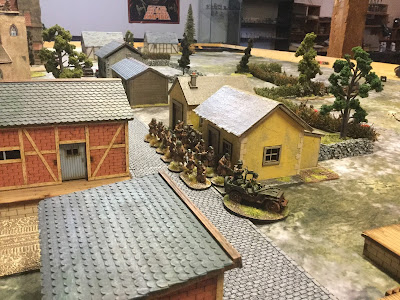This past weekend, we were able to get started on the Bloody Bucket campaign. The first campaign turn was spent with map movement, so can't be chronicled here (both protagonists read this blog).
But the second turn saw the first battle as Mel, playing the German commander, was able to launch an attack on Battlefield Three (in the center of Holzthum) against Michael's Americans. Husband and wife are about to duel!!
For campaign briefings, see here.
Background
This scenario sees the Germans attack into the centre of Holzthum from Assembly Point B, as an Attack & Defend scenario. The Germans begin with all of their Patrol Markers along the edge indicated depending on their approach route. In all situations the US player will place all of his Patrol Markers on the spot on the main road, as shown by the Allied Star.
The US player fields one platoon of infantry with whatever support options that have been allocated to this table for that Campaign Turn.
Supports for this battle:
1 x sniper
1x .50 cal HMG team
1 x 57mm AT gun & crew
Men's Opinion: 0
CO's Outlook: Thoughtful
FM Modifier: 0
Support Modifier: 0
Force Morale: 8
Men's Opinion: 0
CO's Outlook: Thoughtful
FM Modifier: 0
Support Modifier: 0
Force Morale: 8
The German player has a total of 12 support points available when this scenario is first played. On subsequent turns the German player adds a further three points if the game occurs on Day One, five points on Day Two.
The basic force in this battle is a Volksgrenadier Sturm platoon.
Supports purchased for this battle:
1 x LMG section
1 x senior leader
1 x pre-game bombardment
2 x panzerschreck team
Men's Opinion: +3
General's Outlook: Confident
FM Modifier: +2
Support Modifier: 0
General's Outlook: Confident
FM Modifier: +2
Support Modifier: 0
Force Morale: 11
Initial impressions were that the Germans would have some issues having to cross the open ground in front of the town, especially since all German troops are Green. These fears were realized in the Patrol Phase when two of the German JoPs ended up on the table edge. Only one was in a decent position along the hedges in the center. The Americans ended the phase in a comfortable position among the buildings.

The German commander decided on a two-pronged attack. The main thrust would go straight down the center supported by a wide flanking movement to the left.
The German commander began by deploying a LMG section and a senior leader (with the rifle grenadiers) along the hedge. The American commander countered with a rifle section in the buildings.
The LMG section begins its move forward.
The German flanking movement begins. An LMG section dashes froward from the baseline, helped by multiple double phases.
In the center, German sturm sections deploy.
An American rifle section deploys and prepares to counter the German flanking move.
Again aided by the multiple double phases, the German sturmtroopers dash forward under a hail of grenades and assault one of the buildings. This first assault was predictably bloody. The attacking Germans were destroyed and the remainder of the American defenders pinned. Luckily, the German commander had another sturm section waiting to go and sent them forward. This time, the assault was the proverbial cake-walk (what is a cake-walk, anyway?). The pinned American section was destroyed and enough Force Morale was lost to drop the American level to less than 3.
German victory!
As it turned out, the concern over the green quality of the German volksgrenadiers was perhaps overstated. The firepower of the sturm sections and the two LMGs was more than enough to make up for the lesser troop quality. This was especially true in the assault when the sturm sections provided three extra dice per trooper. The wide flanking movement by the German LMG section seemed not to have done much but, in retrospect, it did force the American commander to commit an entire rifle section as a counter. This ultimately weakened the main defensive line. Another factor that seemed to have helped the Germans was the quality of the NCO corps. There is a special rule that makes them harder to hit as leader casualties. This advantage may take a few games for its potential to be fully realized.
With this first victory, the German commander has decided to invoke the Blitzkrieg campaign rule and push onto the next battlefield in the same campaign turn. This move could prove to be a double-edged sword. On one hand, the lure of winning two battles in one campaign turn could potentially speed up the German advance (and speed is of the essence in this campaign). On the other hand, the current force and supports must be used for the second battle in the Blitzkrieg, before adjusting for battlefield casualties in the first battle. And no new supports may be purchased. As well, if the germans lose any battle in a campaign turn, the initiative shifts to the Americans. Regardless, the Germans will now attempt to take Battlefield Two.
The remaining German force for the second battle of the Blitzkrieg:
2 x senior leader (one with a light wound)
2 x panzerschrek team
1 x sturm section
2 x LMG section





































